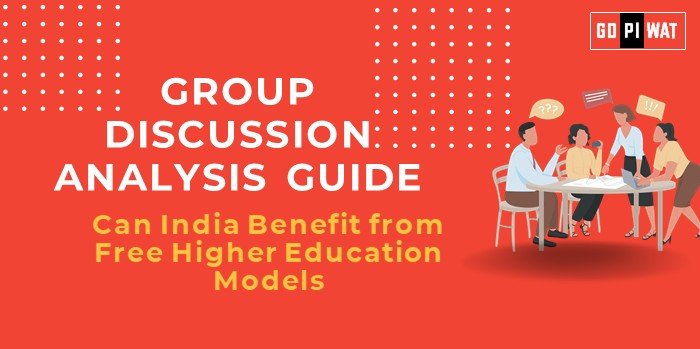📋 Can India Benefit from Free Higher Education Models?
🌐 Group Discussion (GD) Analysis Guide
💡 Introduction to Free Higher Education Models
Opening Context: “Around the world, countries like Germany and Norway have embraced free higher education, fostering equitable access and economic growth. For India, where access to quality higher education remains a challenge, such a model holds transformative potential.”
Background: Free higher education eliminates financial barriers, ensuring that all students, regardless of socioeconomic status, can pursue advanced studies. While India has a growing higher education infrastructure, affordability remains a barrier for millions of students.
📊 Quick Facts and Key Statistics
- 📈 Gross Enrollment Ratio (GER): 27.3% (AISHE 2022), indicating significant room for improvement in higher education accessibility.
- 💰 Average Tuition Cost: ₹30,000–₹50,000/year in public institutions—high for low-income families.
- 🌍 Global Benchmarks: Germany spends 1.3% of its GDP on free higher education, ensuring access without compromising quality.
- 📜 India’s Education Budget (2023-24): ₹1.12 lakh crore, with only a fraction allocated to higher education.
🤝 Stakeholders and Their Roles
- 🏛️ Government: Create policies, allocate funding, and ensure governance of free higher education models.
- 🏫 Educational Institutions: Implement programs that maintain quality while increasing equitable access.
- 👨🎓 Students: Direct beneficiaries of free education, contributing to a more skilled and employable workforce.
- 💼 Private Sector: Collaborators through CSR initiatives, funding scholarships, or public-private partnerships.
- 🏠 Civil Society: Advocates for policies ensuring inclusive and quality education for all.
🏆 Achievements and ⚠️ Challenges
✨ Achievements:
- 📈 Literacy Rate Improvement: Increased from 52% (1991) to 74% (2021), demonstrating progress in educational outreach.
- 🎓 Public Funding: Increased funding for flagship institutions like IITs and IIMs has strengthened India’s global education presence.
- 💻 Digital Learning Initiatives: Platforms like SWAYAM and NPTEL are boosting accessibility for marginalized students.
⚠️ Challenges:
- 💰 Funding Gaps: India’s fiscal constraints limit the feasibility of large-scale free education models.
- 🏫 Overcrowding: Public institutions face challenges like over-enrollment, reducing personalized resources and learning quality.
- 🌐 Rural-Urban Disparity: Quality education remains concentrated in urban centers, leaving rural areas behind.
Global Comparisons:
- 🇳🇴 Nordic Countries: Provide free education with robust student support systems.
- 🇩🇪 Germany: Successfully funds free higher education, focusing on long-term benefits like economic growth and skilled workforce development.
Case Study:
- 📍 Tamil Nadu: The state’s subsidized education policies have improved GER and enhanced employability among graduates.
🗣️ Structured Arguments for Discussion
- Supporting Stance: “Free higher education can bridge socioeconomic divides, fostering an inclusive and skilled workforce critical for India’s growth.”
- Opposing Stance: “India lacks the fiscal capacity to sustain free higher education without compromising quality or infrastructure.”
- Balanced Perspective: “While free higher education is ideal, a phased approach with subsidies for marginalized communities ensures sustainability and inclusivity.”
💬 Effective Discussion Approaches
🔹 Opening Approaches:
- 📊 Data-Driven: “With only 27.3% of youth enrolled in higher education, the financial burden remains a key deterrent for many families.”
- 🌍 Global Example: “Germany’s success in providing free higher education offers valuable insights for India.”
- 🏆 Social Impact: “Higher education as a public good can transform societies by reducing inequalities and increasing upward mobility.”
🔄 Counter-Argument Handling:
- 💡 Funding Challenges: Suggest public-private partnerships to mitigate fiscal pressures and share costs.
- 📈 Long-Term Benefits: Emphasize the economic returns of an educated workforce contributing to GDP growth.
📊 Strategic Analysis of Strengths and Weaknesses
- 💪 Strengths:
- 📈 Potential to improve GER and educational access.
- 🤝 Promotes equitable opportunities for all socioeconomic groups.
- 🔻 Weaknesses:
- 💰 Funding constraints and fiscal challenges.
- 🏫 Risk of quality compromise due to overcrowded institutions.
- 🚀 Opportunities:
- 🌐 Collaborate with ed-tech platforms to reduce costs through digital learning.
- 📊 Emulate global models like Germany for sustainable funding solutions.
- ⚠️ Threats:
- 🏛️ Political and policy resistance to large-scale implementation.
- 💼 Over-reliance on limited public funds for financing education.
📚 Connecting with B-School Applications
- 🌟 Real-World Applications: Use policy analysis, resource allocation strategies, and case studies in projects focusing on social impact.
- 💼 Sample Interview Questions:
- 💬 “How can India emulate Germany’s education model to improve higher education access?”
- 📊 “What are the economic implications of adopting free higher education in India?”
- 💡 Insights for Students: Explore the role of policy frameworks in shaping equitable education systems and economic development.


